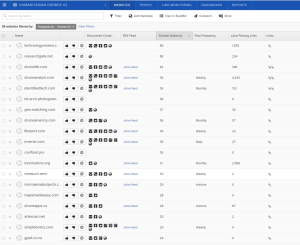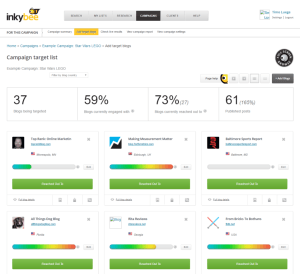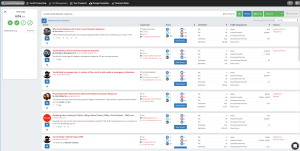For many small or very specialised organizations, press releases are a waste of time. Most of the time, these organisations have neither the name recognition nor an existing network of media contacts, that would help them stand out in the flood of press releases that journalists receive every day. Of course, companies like PR Newswire are happy to help (for a fee), but in my experience, the money and effort that goes into sending out press releases is frequently not worth it. (And yes, it is different if your organization is a household name).
Instead, I find that it makes much more sense for small organizations to identify journalists on social media and bloggers that could be interested in a particular topic, build a relationship and use them to multiply whatever you want to say. And while this approach takes some time, hopefully, your organization does not jump from one topic to the next, so the investment in time will pay off.
There are a large number of web services that promise to help you find influencers on any given topic. I have recently tested three of them to see whether they can help me cut through the clutter and build a list of potential contacts more quickly. Here is what I found:
Buzzstream
From 24 USD/month

At 24 USD/month, Buzzstream (related to Buzzsumo) is the cheapest of the three platforms and there is a lot to like about it: Buzzstream is fast, finds a lot of sources, and provides you with a lot of useful information in an easily digestible format. This includes how often a publication is updated, different ways to contact that publication (Twitter, email, phone, Facebook, etc), and much more. You can give a thumbs up or down to each result and add it to a list of contacts that you want to follow up with later. Buzzstream even allows for complex Boolean search algorithms (AND, OR, NOT) – which is something I love to use – and a variety of filters to narrow the results down further.
However, the feature I probably love most about Buzzstream is that it quickly shows you how many times a publication has talked about your topic and provides direct links to those articles. When looking at bigger online publications that have many authors, this is an essential feature. After all, you probably don’t want to contact “the editor” of Technology Review or QZ, but the individual writer who covered your issue. Last but not least, Buzzstream allows you to create email templates to easily pitch your contacts and the platform will keep track of whom you have already reached out to, who has responded, etc..
Despite all this and I decided that could not stick with Buzzstream. The reason: usability is a nightmare. The “feature” that drove me absolutely nuts is that you can only refine a search term three times – then you have to delete the whole project and start fresh. That makes no sense! I’m the kind of person who likes to create a search query, run it, refine it, run it and refine it again. Being able to make only three changes nearly made me yell in frustration – and that is a feeling I do not want to have to pay for. Even aside from this issue, I found that various tasks involved unnecessary clicks and superfluous actions which overall made Buzzstream too clunky to use. It’s a real shame.
InkyBee
From 79 USD/month

InkyBee is in many ways the opposite of Buzzstream. It is very intuitive to use but much more limited in how it delivers your search results. Something I found particularly annoying is that while you can use all Google operators to search for results, you can only use three AND keywords to create a continuous search. The latter is really practical if you want to be notified when new resources related to your topic come online, but for that to be truly useful the search functionality is too limited.
Where InkyBee shines is reporting. You can very easily see how many people or publications you have in your current list, how many you have reached out to, and what your relationship is with each of them. Colour bars make it easy to see which your most solid relationships are and which need more work.
Unlike the other platforms, InkyBee does not allow you to send emails through the platform or use email templates. This forces users to tailor their outreach more personally – which is not necessarily a bad thing.
The thing I find most disappointing about InkyBee is that it does not give you individual links to articles that mention your search queries but only to the website itself. I mentioned above why I think that is important and it is one of the reasons why I would not choose InkyBee.
InkyBee also seems to return the fewest results. Traditional media outlets hardly show up in their search results at all. You can say that is a good thing – after all it is marketing itself as a blogger outreach tool – but I like a bit more breadth. After all, finding out that a NatGeo or New York Times journalist has covered your topic is a nice thing.
Overall, in my opinion, InkyBee is too expensive for what it gives you.
NinjaOutreach
From 49 USD/month

Ninja Outreach is the third platform I tested and in my opinion the best compromise. The search is not as good as Buzzstream, but the interface is decent. It returns individual articles within an online publication but could do a better job grouping them. Overall the platform leaves the kind of impression where you think “It does the job – and a year from now it might actually be fun to use”.
You can use NinjaOutreach to send emails and store the responses, but I found that recording which actions I have taken in relation to which contact (followed on Twitter, received an email, met for a beer) is a bit cumbersome. Just a small example: I can follow Twitter users from within the platform, but the platform cannot highlight the Twitter users in the results list that I already follow. These aren’t big issues, but for close to 600 USD/year I think we should be able to expect something that is a bit more refined.
The thing I probably like most about NinjaOutreach is that it has a dedicated section for finding people. While the other platforms have that as an afterthought, NinjaOutreach lets you easily find influencers and add them to contact lists. You can even filter by different categories such as “journalist”, “blogger”, and “company”.
What I find very disappointing is that NinjaOutreach doesn’t store your searches which makes it hard to find sources that are new since you last ran the search. This is an aspect where Buzzstream and InkyBee do better. On the other hand, filtering search results works very well, which really helps in narrowing the results down.
All in all, NinjaOutreach is a decent compromise when you have the money. Nothing that will make you jump for joy, but also nothing that will make you angry.
A few general thoughts
One of the things that all platforms do is harvest contact details. While that sounds great in theory, I found that in most cases, the harvesting doesn’t work terribly well. On bigger websites, the scrapers find dozens of email addresses but frequently none that seem to belong to the author. However, all of them performed equally.
Equally, all platforms offer small add-ons or plugins for the most common browsers, through which you can easily add sources to the service. I found these really practical.
Something else you should consider is whether you want to use email templates and send them through the platform or not. If you want to reach a large number of people, these templates can be a real-time saver. Some of the platforms even write follow-up emails after a couple of days, if you didn’t get a response. However, the benefit of saving time needs to be balanced against the risk of sending impersonal emails, potentially with the wrong names. I frequently get pitches and you can definitely tell if it’s a mass mailing.
At the end of the day, you can also do all this with sophisticated Google and Twitter searches and use a spreadsheet (CoSchedule has a free template). It depends on how organized you are and whether you are working by yourself or in a team. The platforms offer more value the harder you find it to organize data yourself and the more people you have to coordinate with.






